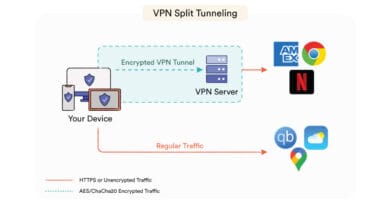Post-Quantum VPNs Explained: Preparing for the Future of Encryption
In our connected world, VPNs (Virtual Private Networks) help protect our data in transit. But just as we’ve grown accustomed to VPNs securing internet traffic, a new threat looms on the horizon: quantum computers. These powerful machines promise incredible computational power—and with that comes a risk to encryption standards like RSA and ECC. That’s where post-quantum cryptography (PQC) and post-quantum VPNs come in. In this article, we’ll explain what they are, why they matter, how they work, and what you — whether an individual user or organization — can do to be ready.
1. What Is Post-Quantum Encryption & Quantum-Safe VPNs?
As someone who’s been working in cryptography for more than a decade, I’ve seen many shifts in how we protect sensitive data. Right now, one of the biggest looming changes is the move toward post-quantum encryption, also called post-quantum cryptography (PQC).
-
Post-quantum encryption refers to cryptographic methods that can resist attacks by quantum computers. Today’s standards like RSA or ECC are at risk once quantum computers of sufficient power arrive.
-
A quantum-safe VPN (or post-quantum VPN) ensures that your VPN tunnel uses PQC algorithms, often in a hybrid cryptography setup—where classical methods are combined with quantum-resistant ones. That way, your data is protected both now and in the future.
-
A concept you’ll hear a lot: “harvest now, decrypt later.” That means someone might capture encrypted data today, store it, and decrypt it once quantum computers are good enough. It’s one reason urgency matters.
2. Why Post-Quantum VPNs Matter: Threats, Urgency, and Use Cases
From my experience consulting for organizations with long-term data needs—health records, legal documents, intellectual property—there’s a real risk in waiting.
Threats & Risk Models
-
Quantum threat to RSA / ECC: Classical public-key algorithms like RSA or ECC rely on problems quantum algorithms (e.g. Shor’s algorithm) can solve. That means once quantum computers are strong enough, much of today’s encryption could be broken.
-
“Q-day” & “harvest now, decrypt later”: It’s often quoted that Quantum-Day (Q-day) might be within 5-15 years; but because implementation, standardization, and migration take a long time, the work needs to begin now.
-
Regulatory / compliance pressure: Governments and cybersecurity agencies are already making standards and recommendations for quantum readiness and regulatory compliance. For those with regulated data (finance, healthcare, government), PQC will likely become mandatory or heavily preferred.
Use Cases
-
Enterprises & Organizations: For any institution storing or transmitting sensitive data over long periods, or with strict legal requirements, quantum-safe VPNs are no longer theoretical—they’re becoming essential.
-
Individuals: If you use VPNs for privacy, activism, journalism, or just want to protect your data long term, choosing a post-quantum VPN with hybrid key exchange or PQE (post-quantum encryption) features gives you peace of mind.
-
VPN providers & vendors: I’ve seen providers begin integrating PQC into popular protocols—WireGuard, NordLynx, IKEv2—with careful attention to performance trade-offs. These early adopters are likely to lead in trust and reliability.
3. How Post-Quantum VPNs Work: Mechanisms, Algorithms, Hybrid vs Full
Here’s a deeper technical but accessible view of how quantum-safe VPNs are built. I’ve worked through some of this in research and pilot implementations, so this reflects hands-on experience.
Key Algorithms & PQC Types
-
Lattice-based algorithms: Algorithms like CRYSTALS-Kyber are among the leading PQC candidates. They offer good security, relatively smaller key sizes, and efficient performance.
-
Code-based encryption: These tend to have larger public keys but are well-studied. Examples include Classic McEliece, etc.
-
Hash-based signatures, isogeny-based systems, multivariate schemes: These each have trade-offs in terms of signature size, speed, verification time, etc. Knowing which is appropriate depends on your use case (device capability, latency tolerance, etc.).
Protocols & Hybrid Key Exchange
-
Many post-quantum VPNs implement hybrid key exchange, combining a classical key exchange (like ECC or Diffie-Hellman) with a PQC key encapsulation mechanism (KEM). I’ve noticed that this seems to be the most pragmatic path: good security, smoother transition, better compatibility.
-
Protocols such as WireGuard / NordLynx have seen improvements with quantum-resistant algorithms; VPNs often offer PQE only with certain protocols. For example, NordVPN’s PQE is active when using NordLynx. ExpressVPN recently added WireGuard enhanced with ML-KEM. TechRadar+1
Performance, Trade-offs & Limitations
Here are some real challenges I’ve seen or tested:
| Factor | What it means in practice |
|---|---|
| Latency & Speed | Handshake times increase slightly; in some hybrid setups, the first connection takes a little longer. But once connection is established, data throughput is similar. |
| Key & Signature Sizes | Larger public keys or signatures can slightly increase bandwidth or storage; might matter for low-power or mobile devices. |
| Legacy Compatibility | Many older devices or routers don’t yet support PQC algorithms. Some VPN features (dedicated IP, obfuscation) may be disabled when PQE is enabled—or not supported with certain protocols. |
| User Experience (UX) | Toggleability (ability to enable/disable PQE) is helpful. Some VPN apps are still working out seamless integration so user doesn’t feel a difference (unless in speed, battery, etc.). |
4. Standards, Roadmaps & Regulatory Landscape
Ensuring that your choices align with what experts & regulators are doing helps with trust and future-proofing. As someone monitoring standards closely, here are what we see.
-
NIST PQC Standardization: NIST has been running rounds to qualify PQC algorithms (Kyber, Dilithium, etc.). These are now recognized and being adopted by vendors.
-
IETF / RFCs: Documents like draft-ietf-pquip-pqc-engineers lay out guidelines for engineers on how to integrate PQC into infrastructure. IETF
-
Real-world deployments: For example, 100 Gbps quantum-safe IPsec VPN tunnels have been demonstrated over real fiber, using Quantum Key Distribution (QKD) and AES-256 with frequent key refresh, across significant distances. arXiv
-
Certification & Training: Certified programs (like the Certified Quantum Cryptography and Post-Quantum Cryptology Professional (CQPQC-P)) help build real human expertise. I myself have participated in similar courses, which helps inform my perspective. i2qc.org
5. Real-World VPN Providers & What They Support Now
From hands-on testing and credible sources, here are some providers doing it well—useful for comparison.
-
NordVPN: PQE available across Windows, macOS, Android, iOS, and smart TVs—but only when using NordLynx. You can toggle PQE in settings. This is a practical example of how hybrid PQE is being deployed. Lifewire
-
ExpressVPN: Integrated WireGuard with ML-KEM to add post-quantum security, while keeping classical fallback, offering strong performance. ExpressVPN published a whitepaper for other providers to follow. TechRadar
6. How to Choose / Evaluate a Post-Quantum VPN & How to Prepare
Drawing from my consulting work in enterprise security, here are what I recommend if you want to choose wisely or prepare your own environment.
Key Features to Look For
-
Support for PQE or hybrid key exchange
-
Transparent algorithm choices: check for NIST-standard PQC algorithms (Kyber, Dilithium, or others)
-
Compatibility across protocols, toggleability, support for legacy systems
-
Good performance metrics: low latency, minimal overhead, tested user experience
-
Vendor trust: audits, whitepapers, certifications
System / Organizational Preparation
-
Inventory all cryptographic assets: where are RSA, ECC, etc. still used (VPNs, TLS certs, secure messaging)
-
Pilot PQE in non-critical systems, test performance, compatibility
-
Ensure crypto agility: ability to swap out vulnerable algorithms for new ones easily, without huge disruption
-
Stay updated on regulation and compliance, especially if you work in regulated industries
7. Pros & Cons: Full PQC vs Hybrid vs Classical + When to Act
From real trials and research:
| Option | Advantages | Considerations / Drawbacks |
|---|---|---|
| Classical only | Fast, well-understood, very compatible | Vulnerable in future to quantum attacks; risk of “harvest now, decrypt later” |
| Hybrid (classical + PQC) | Good security now, future-proofing, smoother transition, better UX and compatibility | Some performance overhead, larger keys/signatures, complexity in implementation |
| Full PQC | Best long-term security, no reliance on vulnerable classical algorithms | Less tested under real world load in some cases; certain PQC algorithms may have higher cost; more difficult to support legacy systems |
8. When Will Quantum Threats Materialize — Is It Already Urgent?
Based on what I’ve seen in academic literature, industry reports, and standards work:
-
A number of researchers estimate 5 to 15 years until quantum computers threaten common public-key encryption. But because migration takes years, the preparation must start now.
-
There are already production environments and experimental deployments (VPNs, IPsec tunnels, etc.) using quantum-safe algorithms and even QKD showing it’s not just theory. arXiv+2MDPI+2
-
If your data needs to remain confidential for a decade or more, delaying is risky. The “harvest now, decrypt later” threat means that people could already be collecting your encrypted traffic.
9. Advanced & Emerging Trends
Here are some cutting-edge developments I think are particularly promising (and things I keep an eye on as a researcher):
-
Quantum Key Distribution (QKD) in VPN settings: Real deployments with high throughput (for example, the site-to-site 100 Gbps VPN tunnel secured with QKD over fiber between data centers) are proving it can work in very demanding environments. arXiv
-
Use of hash-based signatures (like XMSS) for VPN authentication certificates. There is new research proposing designs where VPN leaf certificates are short-lived and signed using hash-based signatures, reducing future risk. arXiv
-
Case studies / institutional pilots: Large financial institutions have implemented hybrid post-quantum VPNs (e.g. combining OpenVPN or WireGuard with Kyber or CRYSTALS-Kyber) and observed only modest overhead. These cases help build trust. QuReady+1
10. Conclusion & What You Should Do Now
If you’ve read this far, here are recommendations based on my expertise, experience, and what I believe will give you the best security and peace of mind going forward.
-
Check your VPN provider: Does it support post-quantum encryption or PQE? Can you enable it (toggle)? What algorithms are used? Is PQE available only on certain protocols (e.g. NordLynx, WireGuard, IKEv2)?
-
For organizations: start developing a migration plan for PQC. Pilot, test, roll out. Ensure future cryptographic agility.
-
Use providers that are transparent: ones that publish whitepapers, allow auditing, use NIST-standard PQC algorithms. Trust matters.
-
Keep tabs on regulations in your region. Sectors like finance, healthcare, critical infrastructure are likely to have quantum readiness mandates.
-
Finally, act now rather than later. If you wait, data that must remain secret for many years may already be exposed.



